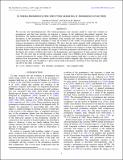Files in this item
3D whole-prominence fine structure modeling. II. Prominence evolution
Item metadata
| dc.contributor.author | Gunar, Stanislav | |
| dc.contributor.author | Mackay, Duncan Hendry | |
| dc.date.accessioned | 2015-10-22T08:40:00Z | |
| dc.date.available | 2015-10-22T08:40:00Z | |
| dc.date.issued | 2015-10-20 | |
| dc.identifier | 223495960 | |
| dc.identifier | d271d799-432b-4862-8225-6d2797379d9d | |
| dc.identifier | 85043636925 | |
| dc.identifier | 000365206600005 | |
| dc.identifier.citation | Gunar , S & Mackay , D H 2015 , ' 3D whole-prominence fine structure modeling. II. Prominence evolution ' , Astrophysical Journal , vol. 812 , 93 . https://doi.org/10.1088/0004-637X/812/2/93 | en |
| dc.identifier.issn | 0004-637X | |
| dc.identifier.other | ORCID: /0000-0001-6065-8531/work/58055437 | |
| dc.identifier.uri | https://hdl.handle.net/10023/7683 | |
| dc.description.abstract | We use the new three-dimensional (3D) whole-prominence fine structure model to study the evolution of prominences and their fine structures in response to changes in the underlying photospheric magnetic flux distribution. The applied model combines a detailed 3D prominence magnetic field configuration with a realistic description of the prominence plasma distributed along multiple fine structures. In addition, we utilize an approximate Hα visualization technique to study the evolution of the visible cool prominence plasma both in emission (prominence) and absorption (filament). We show that the initial magnetic field configuration of the modeled prominence is significantly disturbed by the changing position of a single polarity of a magnetic bipole as the bipole is advected toward the main body of the filament. This leads to the creation of a barb, which becomes the dominant feature visible in the synthetic Hα images of both the prominence and filament views. The evolution of the bipole also creates conditions that lead to the disappearance and reappearance of large portions of the main body. We also show that an arch-like region containing a dark void (a bubble) can be naturally produced in the synthetic prominence Hα images. While not visible in terms of the magnetic field lines, it is due to a lack of Hα emission from low-pressure, low-density plasma located in shallow magnetic dips lying along the lines of sight intersecting the dark void. In addition, a quasi-vertical small-scale feature consisting of short and deep dips, piled one above the other, is produced. | |
| dc.format.extent | 13 | |
| dc.format.extent | 2368561 | |
| dc.language.iso | eng | |
| dc.relation.ispartof | Astrophysical Journal | en |
| dc.subject | Radiative transfer | en |
| dc.subject | Sun: filaments | en |
| dc.subject | Prominences - Sun | en |
| dc.subject | Magnetic fields | en |
| dc.subject | QB Astronomy | en |
| dc.subject | QC Physics | en |
| dc.subject | NDAS | en |
| dc.subject.lcc | QB | en |
| dc.subject.lcc | QC | en |
| dc.title | 3D whole-prominence fine structure modeling. II. Prominence evolution | en |
| dc.type | Journal article | en |
| dc.contributor.sponsor | Science & Technology Facilities Council | en |
| dc.contributor.sponsor | The Leverhulme Trust | en |
| dc.contributor.institution | University of St Andrews. Applied Mathematics | en |
| dc.identifier.doi | https://doi.org/10.1088/0004-637X/812/2/93 | |
| dc.description.status | Peer reviewed | en |
| dc.identifier.grantnumber | ST/K000950/1 | en |
| dc.identifier.grantnumber | IN-2014-016 | en |
This item appears in the following Collection(s)
Items in the St Andrews Research Repository are protected by copyright, with all rights reserved, unless otherwise indicated.

